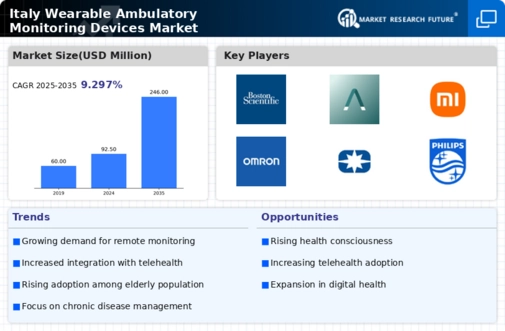Growing Aging Population
Italy's aging population is a significant driver for the wearable ambulatory-monitoring-devices market. With approximately 23% of the population aged 65 and older, there is an increasing need for health monitoring solutions tailored to the elderly. Wearable devices can assist in managing chronic conditions, ensuring medication adherence, and providing emergency alerts. By 2025, the market for wearable devices aimed at seniors is expected to grow by 20%, reflecting the urgent demand for innovative healthcare solutions. This demographic shift necessitates the development of user-friendly devices that cater to the specific needs of older adults, thereby propelling the wearable ambulatory-monitoring-devices market forward. As families and caregivers seek reliable ways to monitor the health of their loved ones, the adoption of these technologies is likely to rise.
Focus on Preventive Healthcare
The growing emphasis on preventive healthcare is reshaping the landscape of the wearable ambulatory-monitoring-devices market. In Italy, healthcare policies are increasingly prioritizing prevention over treatment, encouraging individuals to take charge of their health. This shift is reflected in the rising adoption of wearable devices that facilitate early detection of health issues. By 2025, it is anticipated that the market for preventive health technologies will expand by 18%, driven by consumer awareness and demand for proactive health management. Wearable devices play a vital role in this paradigm shift, enabling users to monitor vital signs and lifestyle factors that contribute to overall health. As the focus on prevention intensifies, the wearable ambulatory-monitoring-devices market is poised for substantial growth.
Increased Investment in Health Technology
The surge in investment in health technology is a crucial factor influencing the wearable ambulatory-monitoring-devices market. In Italy, both public and private sectors are channeling funds into innovative health solutions, with investments reaching approximately €500 million in 2025. This financial backing is fostering research and development, leading to the creation of advanced wearable devices that offer enhanced functionalities. As healthcare providers and technology companies collaborate, the market is likely to witness the introduction of cutting-edge devices that cater to diverse health needs. This influx of capital not only accelerates technological advancements but also promotes competition among manufacturers, ultimately benefiting consumers through improved product offerings in the wearable ambulatory-monitoring-devices market.
Integration with Mobile Health Applications
The integration of wearable ambulatory-monitoring-devices with mobile health applications is transforming the healthcare landscape in Italy. This synergy allows users to seamlessly track their health metrics, receive personalized feedback, and engage in proactive health management. As of 2025, it is projected that over 60% of wearable device users in Italy will utilize mobile applications for data analysis and health insights. This trend not only enhances user experience but also encourages adherence to health regimens. The wearable ambulatory-monitoring-devices market is thus likely to benefit from this integration, as it fosters a more interactive and user-friendly approach to health monitoring. Furthermore, the data collected through these applications can provide valuable insights for healthcare providers, potentially leading to improved patient outcomes.
Rising Demand for Remote Patient Monitoring
The increasing demand for remote patient monitoring is a pivotal driver in the wearable ambulatory-monitoring-devices market. As healthcare systems in Italy strive to enhance patient care while reducing costs, the adoption of wearable devices has surged. In 2025, it is estimated that the market for remote monitoring solutions could reach €1.5 billion, reflecting a growth rate of approximately 15% annually. This trend is largely fueled by the need for continuous health monitoring, especially among chronic disease patients. The convenience and accessibility offered by these devices enable healthcare providers to track patient health metrics in real-time, thereby improving clinical outcomes. Consequently, the wearable ambulatory-monitoring-devices market is likely to expand as more healthcare professionals recognize the benefits of integrating these technologies into their practices.
























Leave a Comment